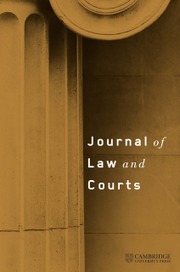Crossref Citations
This article has been cited by the following publications. This list is generated based on data provided by
Crossref.
Hinkle, Rachael K.
2015.
Legal Constraint in the US Courts of Appeals.
The Journal of Politics,
Vol. 77,
Issue. 3,
p.
721.
Habel, Philip
Bennett, Daniel
Gleason, Shane A.
and
Comparato, Scott A.
2015.
The Implications of Salary for the Quality of Nominations to the Federal District Courts, 1964–2012.
Justice System Journal,
Vol. 36,
Issue. 4,
p.
323.
Miles, Thomas J.
2015.
Do Attorney Surveys Measure Judicial Performance or Respondent Ideology? Evidence from Online Evaluations.
The Journal of Legal Studies,
Vol. 44,
Issue. S1,
p.
S231.
Sen, Maya
2015.
Is Justice Really Blind? Race and Reversal in US Courts.
The Journal of Legal Studies,
Vol. 44,
Issue. S1,
p.
S187.
Hanretty, Chris
2016.
Lawyer rankings either do not matter for litigation outcomes or are redundant.
International Journal of the Legal Profession,
Vol. 23,
Issue. 2,
p.
185.
Ransbotham, Sam
Overby, Eric M.
and
Jernigan, Michael C.
2016.
Electronic Trace Data and Legal Outcomes: The Effect of Electronic Medical Records on Malpractice Claim Resolution Time.
SSRN Electronic Journal,
Bonica, Adam
2017.
Why Are There So Many Lawyers in Congress?.
SSRN Electronic Journal ,
Bonica, Adam
and
Sen, Maya
2017.
The Politics of Selecting the Bench from the Bar: The Legal Profession and Partisan Incentives to Introduce Ideology into Judicial Selection.
The Journal of Law and Economics,
Vol. 60,
Issue. 4,
p.
559.
Subramanian, Hemang
and
Overby, Eric
2017.
Electronic Commerce, Spatial Arbitrage, and Market Efficiency.
Information Systems Research,
Vol. 28,
Issue. 1,
p.
97.
Nelson, Michael J.
and
Hinkle, Rachael K.
2018.
Crafting the Law: How Opinion Content Influences Legal Development.
Justice System Journal,
Vol. 39,
Issue. 2,
p.
97.
Holmes, Lisa M.
2018.
Race, Gender, Sexuality, and the Politics of the American Judiciary.
p.
140.
Brazelton, Shenita
and
Chaffin-DeHaan, LaTasha
2018.
Race, Gender, Sexuality, and the Politics of the American Judiciary.
p.
123.
Boyd, Christina L.
Collins, Paul M.
and
Ringhand, Lori A.
2018.
The Role of Nominee Gender and Race at U.S. Supreme Court Confirmation Hearings.
Law & Society Review,
Vol. 52,
Issue. 4,
p.
871.
Goelzhauser, Greg
2018.
Does Merit Selection Work?.
Journal of Law and Courts,
Vol. 6,
Issue. 1,
p.
155.
Budziak, Jeffrey
and
Lempert, Daniel
2018.
Assessing Threats to Inference with Simultaneous Sensitivity Analysis: The Case of US Supreme Court Oral Arguments.
Political Science Research and Methods,
Vol. 6,
Issue. 1,
p.
33.
Knepper, Matthew
2018.
When the Shadow Is the Substance: Judge Gender and the Outcomes of Workplace Sex Discrimination Cases.
Journal of Labor Economics,
Vol. 36,
Issue. 3,
p.
623.
Joshi, Amol M.
Inouye, Todd M.
and
Robinson, Jeffrey A.
2018.
How does agency workforce diversity influence Federal R&D funding of minority and women technology entrepreneurs? An analysis of the SBIR and STTR programs, 2001–2011.
Small Business Economics,
Vol. 50,
Issue. 3,
p.
499.
Kokkodis, Marios
and
Lappas, Theodoros
2019.
Your Hometown Matters: Popularity-Difference Bias in Online Reputation Platforms.
SSRN Electronic Journal ,
Harris, Allison P.
and
Sen, Maya
2019.
Bias and Judging.
Annual Review of Political Science,
Vol. 22,
Issue. 1,
p.
241.
Boddery, Scott S.
Moyer, Laura P.
and
Yates, Jeff
2019.
Naming Names: The Impact of Supreme Court Opinion Attribution on Citizen Assessment of Policy Outcomes.
Law & Society Review,
Vol. 53,
Issue. 2,
p.
353.




